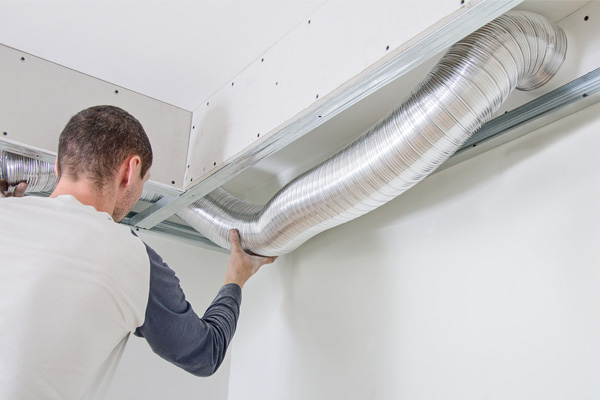Energy Inefficiency:
Inefficient use of energy is one of the main problems caused by ducts that are leaking. Leaky ducts prevent conditioned air from reaching its target and instead allow it to escape into unconditioned areas like basements, crawl spaces, or attics. Heating and cooling systems become less efficient and energy is wasted as a result. Higher energy usage and utility bills are the results of the HVAC system having to work harder and longer to make up for the air that has been lost.
Uneven heating and cooling can also be caused by duct leaks. Because of ductwork leaks, rooms farther away from the HVAC unit may not receive enough conditioned air, which can lead to discomfort for those living there. Occupants may feel the need to modify their thermostats to make up for the temperature differences, which can result in even more energy consumption and expenses.
Indoor Air Quality Decrease:
Lower indoor air quality (IAQ) is another consequence of duct leaks. Airborne particles including dust, pollen, dirt, and mould spores can spread throughout a building if ducts aren’t properly sealed. Another consequence of leaks is the creation of negative pressure within the duct system. This, in turn, pulls outside air into the structure through any openings such as windows, doors, or cracks. Contaminants, pollutants, and allergies in the outdoor air can degrade indoor air quality.
Respiratory disorders, allergies, and worsened asthma symptoms are just a few of the many health problems that can result from poor indoor air quality. Pollutants in the air can cause a variety of symptoms, including but not limited to: coughing, sneezing, lethargy, headaches, and exhaustion. Mould development in ducts as a result of water water seepage from leaks is another factor that can worsen indoor air quality problems and endanger the health of building residents.
Increased Utility Costs:
Building owners and occupants may also notice an increase in their utility bills if there are any leaks in the ducts. In order to keep the building at the ideal temperature, the HVAC system has to work harder and longer to prevent conditioned air from escaping through leaks, as already indicated. More work means more energy consumption and more money spent on heating and cooling.
Leaky ducts not only increase energy expenses, but they can also increase the frequency of HVAC maintenance and repairs. Overuse and inefficiency put a strain on the system, which can cause parts like fans, motors, and compressors to break down sooner rather than later. Keeping up with routine duct inspections and repairs is essential for fixing leaks and preventing more damage to the HVAC system. This adds to the overall expense of building mechanical system maintenance.
Adverse Environmental Impact:
Environmental deterioration is another consequence of leaking ducts in addition to the direct impacts on building occupants and utility expenditures. Buildings have an even larger carbon footprint due to the increased energy demand caused by conditioned air loss, which in turn increases greenhouse gas emissions. Air conditioning and heating systems add to pollution and global warming when they work harder to fix leaks, which means they need more power or fossil fuels.
Inefficient heating, ventilation, and air conditioning (HVAC) systems significantly increase pollution and the depletion of natural resources due to their operation. More fossil fuels—coal, oil, and natural gas—may have to be extracted and burned to meet the rising demand for energy. These resources are limited and have major negative effects on the environment.
Structural Damage and Maintenance Costs:
Buildings with leaking ducts are more likely to sustain structural damage and have higher maintenance expenditures in the long run. Building elements including insulation, plasterboard, and wood frame are susceptible to water damage, rot, and decay when moisture infiltrates via duct leaks. Mould, which can weaken indoor air quality and necessitate expensive cleanup measures, can also be fostered by persistent moisture problems.
Legal and Regulatory Compliance:
Leaky ducts are a potential headache when it comes to meeting requirements for indoor air quality, energy efficiency, and building codes. To encourage energy efficiency, decrease emissions of greenhouse gases, and guarantee healthy indoor environments, numerous governments have implemented rules and regulations. Buildings that have ducts that are leaking could not be able to meet these standards, which could result in fines or even legal action against the building.
In addition, HVAC systems that fail to fulfil performance and efficiency standards may be disqualified from green building certifications like LEED (Leadership in Energy and Environmental Design), ENERGY STAR, or Green Globes. If you want to show that you care about the environment and want to get certified, you may need to upgrade your ductwork and make your HVAC system more efficient.
Fire and Safety Hazards:
Buildings with leaking ducts are more likely to experience fires and other safety issues, particularly if the ducts are situated in or near areas that are flammable. The danger of fire increases when hot air from HVAC systems comes into touch with combustible items like insulation, paper, or wood frame, which can happen when ducts leak. Furthermore, if there are any holes in the ducting, smoke and fire can easily spread throughout the building, making it more difficult for people to safely evacuate in case of an emergency.
There is also the issue of carbon monoxide (CO) and other combustion byproducts seeping into buildings through ducting leakage. Combustion appliances and HVAC systems can release CO, a gas that is both colourless and odourless, when they are not functioning properly. Contamination of indoor rooms by carbon monoxide (CO) can cause poisoning and other severe health problems or even death if duct ruptures allow CO to enter. To reduce these fire and safety risks and make sure everyone in the building is safe, ducting must be inspected and maintained regularly.


